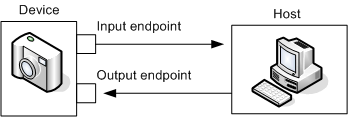使用 USB DV 視訊裝置
[與此頁面相關的功能 DirectShow是舊版功能。 它已被 MediaPlayer、 IMFMediaEngine和 Media Foundation 中的音訊/視訊擷取取代。 這些功能已針對Windows 10和Windows 11進行優化。 Microsoft 強烈建議新程式碼盡可能使用 MediaPlayer、 IMFMediaEngine 和 音訊/視訊擷取 ,而不是 DirectShow。 Microsoft 建議使用舊版 API 的現有程式碼盡可能重寫為使用新的 API。
本主題描述如何撰寫通用序列匯流排 (USB) 視訊裝置的應用程式,以擷取 DV 視訊。
標準 DV 格式的資料速率大約為每秒 25 MB, (Mbps) 。 第一次引進 USB 時,它沒有足夠的頻寬可支援 DV 視訊。 不過,USB 2.0 最多可支援 480 Mbps,這比 DV 視訊還多。 在 2003 年發行的 USB 視訊裝置類別 (UVC) 規格會定義 USB DV 視訊裝置的承載格式。 Windows XP Service Pack 2 中引進了適用于 UVC 裝置的 Windows 驅動程式模型 (WDM) 類別驅動程式。
在大部分方面,UVC 驅動程式支援與 IEEE 1394 裝置的 MSDV 驅動程式相同的程式設計模型。 針對 MSDV 撰寫的應用程式應該只需要稍微修改才能支援 UVC 裝置。
UVC 驅動程式的行為與下欄區域中的 MSDV 驅動程式不同:
若要判斷正在使用哪一個驅動程式,請呼叫 IAMExtDevice::get_DevicePort。 MSDV 驅動程式會傳回DEV_PORT_1394旗標,而 UVC 驅動程式會傳回DEV_PORT_USB旗標。
裝置節點
在 USB 術語中,端點是資料進入或離開裝置的點。 端點具有資料流程的方向,可能是從裝置到主機) 的輸入 (,或是從主機到裝置) 輸出 (。 這可能有助於將這些方向視為相對於主機。 輸入會移至主機;輸出來自主機。 下圖說明兩個端點。

在 UVC 裝置中,裝置的功能會以邏輯方式分成稱為單位和終端機的元件。 單位會接收一或多個資料流程做為輸入,並只傳遞一個資料流程做為輸出。 終端機是資料流程的起點或結束點。 USB 端點對應至終端機,但方向反轉:輸入端點是由輸出終端機表示,反之亦然。 下圖顯示終端機與端點之間的關聯性。

此外,並非所有終端機都對應至 USB 端點。 端點一詞特別是指 USB 連線,而裝置可以透過非 USB 連線來傳送或接收資料。 例如,視訊相機是輸入終端機,而 LED 螢幕則是輸出終端機。
在 KS Proxy 篩選準則中,單位和終端機會以篩選內的節點表示。 「節點」一詞比「單位」和「終端機」更一般,因為非 USB 裝置也可以有節點。 若要取得篩選中節點的相關資訊,請查詢 IKsTopologyInfo 介面的篩選準則。 節點類型是由 GUID 識別。 選取器節點是可以在兩個或多個輸入之間切換的節點。 選取器節點會公開 ISelector 介面。
下列程式碼會測試篩選準則上的輸出針腳是否從指定類型的節點接收輸入。
// Structure to hold topology information.
struct TopologyConnections
{
KSTOPOLOGY_CONNECTION *connections; // Array of connections
DWORD count; // Number of elements in the array
};
/////////////////////////////////////////////////////////////////////
// Name: GetTopologyConnections
// Desc: Gets the topology information from a filter.
//
// pTopo: Pointer to the filter's IKsTopologyInfo interface.
// connectInfo: Pointer to a TopologyConnections structure. The
// function fills in this structure.
//
// Note: If the function succeeds, call CoTaskMemFree to free the
// pConnectInfo->connections array.
/////////////////////////////////////////////////////////////////////
HRESULT GetTopologyConnections(
IKsTopologyInfo *pTopo,
TopologyConnections *pConnectInfo
)
{
DWORD count;
HRESULT hr = pTopo->get_NumConnections(&count);
if (FAILED(hr))
{
return hr;
}
pConnectInfo->count = count;
pConnectInfo->connections = NULL;
if (count > 0)
{
// Allocate an array for the connection information.
SIZE_T cb = sizeof(KSTOPOLOGY_CONNECTION) * count;
KSTOPOLOGY_CONNECTION *pConnections =
(KSTOPOLOGY_CONNECTION*) CoTaskMemAlloc(cb);
if (pConnections == NULL)
{
return E_OUTOFMEMORY;
}
// Fill the array.
for (DWORD ix = 0; ix < count; ix++)
{
hr = pTopo->get_ConnectionInfo(ix, &pConnections[ix]);
if (FAILED(hr))
{
break;
}
}
if (SUCCEEDED(hr))
{
pConnectInfo->connections = pConnections;
}
else
{
CoTaskMemFree(pConnections);
}
}
return hr;
}
/////////////////////////////////////////////////////////////////////
// Name: IsNodeDownstreamFromNode
// Desc: Searches upstream from a node for a specified node type.
//
// pTopo: Pointer to the filter's IKsTopologyInfo interface.
// connectInfo: Contains toplogy information. To fill in this
// structure, call GetTopologyConnections.
// nodeID: ID of the starting node in the search.
// nodeType: Type of node to find.
// pIsConnected: Receives true if connected, or false otherwise.
//
// Note: If the source node matches the type, this function returns
// true without searching upstream.
/////////////////////////////////////////////////////////////////////
HRESULT IsNodeDownstreamFromNode(
IKsTopologyInfo *pTopo,
const TopologyConnections& connectInfo,
DWORD nodeID,
const GUID& nodeType,
bool *pIsConnected
)
{
*pIsConnected = false;
// Base case for recursion: check the source node.
GUID type;
HRESULT hr = pTopo->get_NodeType(nodeID, &type);
if (FAILED(hr))
{
return hr;
}
if (type == nodeType)
{
*pIsConnected = true;
return S_OK;
}
// If the source node is a selector, get the input node.
CComPtr<ISelector> pSelector;
hr = pTopo->CreateNodeInstance(nodeID, __uuidof(ISelector),
(void**)&pSelector);
if (SUCCEEDED(hr))
{
DWORD sourceNodeID;
hr = pSelector->get_SourceNodeId(&sourceNodeID);
if (SUCCEEDED(hr))
{
// Recursive call with the selector's input node.
return IsNodeDownstreamFromNode(pTopo, connectInfo,
sourceNodeID, nodeType, pIsConnected);
}
}
else if (hr == E_NOINTERFACE)
{
hr = S_OK; // This node is not a selector. Not a failure.
}
else
{
return hr;
}
// Test all of the upstream connections on this pin.
for (DWORD ix = 0; ix < connectInfo.count; ix++)
{
if ((connectInfo.connections[ix].ToNode == nodeID) &&
(connectInfo.connections[ix].FromNode != KSFILTER_NODE))
{
// FromNode is connected to the source node.
DWORD fromNode = connectInfo.connections[ix].FromNode;
// Recursive call with the upstream node.
bool bIsConnected;
hr = IsNodeDownstreamFromNode(pTopo, connectInfo,
fromNode, nodeType, &bIsConnected);
if (FAILED(hr))
{
break;
}
if (bIsConnected)
{
*pIsConnected = true;
break;
}
}
}
return hr;
}
/////////////////////////////////////////////////////////////////////
// Name: GetNodeUpstreamFromPin
// Desc: Finds the node connected to an output pin.
//
// connectInfo: Contains toplogy information. To fill in this
// structure, call GetTopologyConnections.
// nPinIndex: Index of the output pin.
// pNodeID: Receives the ID of the connected node.
/////////////////////////////////////////////////////////////////////
HRESULT GetNodeUpstreamFromPin(
const TopologyConnections& connectInfo,
UINT nPinIndex,
DWORD *pNodeID
)
{
bool bFound = false;
for (DWORD ix = 0; ix < connectInfo.count; ix++)
{
if ((connectInfo.connections[ix].ToNode == KSFILTER_NODE) &&
(connectInfo.connections[ix].ToNodePin == nPinIndex))
{
*pNodeID = connectInfo.connections[ix].FromNode;
bFound = true;
break;
}
}
if (bFound)
{
return S_OK;
}
else
{
return E_FAIL;
}
}
/////////////////////////////////////////////////////////////////////
// Name: IsPinDownstreamFromNode
// Desc: Tests whether an output pin gets data from a node of
// a specified type.
//
// pFilter: Pointer to the filter's IBaseFilter interface.
// UINT: Index of the output pin to test.
// nodeType: Type of node to find.
// pIsConnected: Receives true if connected; false otherwise.
/////////////////////////////////////////////////////////////////////
HRESULT IsPinDownstreamFromNode(
IBaseFilter *pFilter,
UINT nPinIndex,
const GUID& nodeType,
bool *pIsConnected
)
{
CComQIPtr<IKsTopologyInfo> pTopo(pFilter);
if (pTopo == NULL)
{
return E_NOINTERFACE;
}
// Get the topology connection information.
TopologyConnections connectionInfo;
HRESULT hr = GetTopologyConnections(pTopo, &connectionInfo);
if (FAILED(hr))
{
return hr;
}
// Find the node upstream from this pin.
DWORD nodeID;
hr = GetNodeUpstreamFromPin(connectionInfo, nPinIndex, &nodeID);
if (SUCCEEDED(hr))
{
bool isConnected;
hr = IsNodeDownstreamFromNode(pTopo, connectionInfo,
nodeID, nodeType, &isConnected);
if (SUCCEEDED(hr))
{
*pIsConnected = isConnected;
}
}
CoTaskMemFree(connectionInfo.connections);
return hr;
}
相關主題